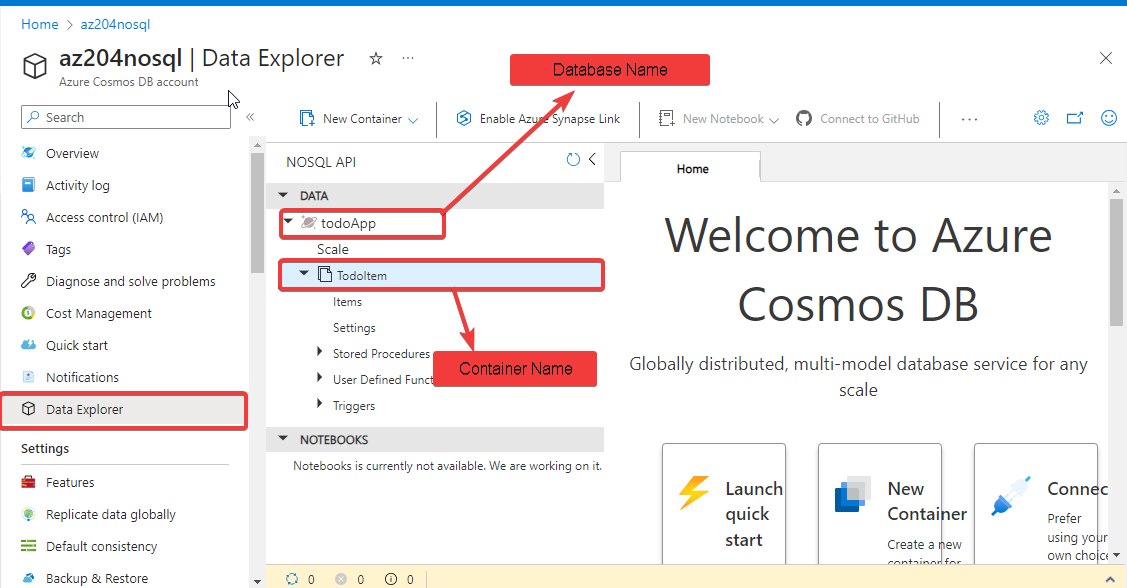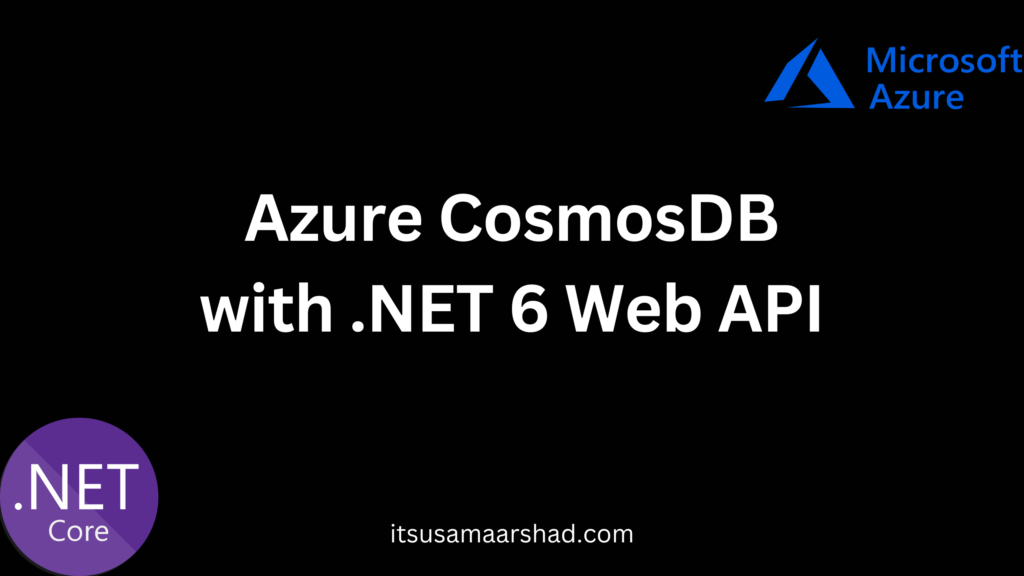Azure Cosmos DB is a globally distributed, multi-model NoSQL database service provided by Microsoft Azure. It is designed to handle large-scale, high-performance applications that require low-latency access to data.
Azure Cosmos DB Benefits:
- Azure Cosmos DB offers support for multiple data models, including document, key-value, graph, and column-family, allowing developers to choose the most appropriate data model for their applications.
- It provides automatic scaling, high availability, and global replication, ensuring that your data is always accessible and protected.
- With its flexible and powerful features, Azure Cosmos DB enables developers to build and scale globally distributed applications with ease.
.NET Core API with Azure Cosmos DB SQL integration
Step 1: Create a new .NET Core API Project Open your preferred IDE (such as Visual Studio or Visual Studio Code) and create a new .NET Core API project.
Step 2: Install required packages In your project, you’ll need to install the following NuGet packages:
dotnet add package Microsoft.Azure.Cosmos
Step 3: Configure Azure Cosmos DB SQL connection In the appsettings.json file, add the Azure Cosmos DB SQL connection settings:
"CosmosDbSettings": {
"EndpointUri": "<YOUR_COSMOS_DB_ENDPOINT_URI>",
"PrimaryKey": "<YOUR_COSMOS_DB_PRIMARY_KEY>",
"DatabaseName": "<YOUR_COSMOS_DB_DATABASE_NAME>",
"ContainerName": "<YOUR_COSMOS_DB_CONTAINER_NAME>"
}
Step 3: Go to azure portal https://portal.azure.com/
- Go to create resource.
- Search Cosmos DB.
- Create Cosmos DB SQL.
- Go To Data Explore And Click To Create Container.
- Add name of database, container and set Id to Partition Id.
- Click OK button our database and container is ready to use.
- Copy and pate the Database and Container Name in appsettings.json file.
- To get EndpointUri and Primary key click on key from left menu.


Step 4: Create a TodoItem model class that represents the data you want to store in Cosmos DB.
public class TodoItem
{
[JsonProperty("id")]
public string Id { get; set; }
[JsonProperty("title")]
public string Title { get; set; }
[JsonProperty("isCompleted")]
public bool IsCompleted { get; set; }
}
Step 5: Create a repository class Create a repository class that handles the CRUD operations with Azure Cosmos DB.
public class TodoRepository
{
private readonly Container _container;
public TodoRepository(IConfiguration configuration)
{
var cosmosDbSettings = configuration.GetSection("CosmosDbSettings").Get<CosmosDbSettings>();
var cosmosClient = new CosmosClient(cosmosDbSettings.EndpointUri, cosmosDbSettings.PrimaryKey);
var database = cosmosClient.GetDatabase(cosmosDbSettings.DatabaseName);
_container = database.GetContainer(cosmosDbSettings.ContainerName);
}
public async Task<IEnumerable<TodoItem>> GetTodoItems()
{
var sqlQuery = new QueryDefinition("SELECT * FROM c");
var queryResultSetIterator = _container.GetItemQueryIterator<TodoItem>(sqlQuery);
var todoItems = new List<TodoItem>();
while (queryResultSetIterator.HasMoreResults)
{
var currentResultSet = await queryResultSetIterator.ReadNextAsync();
todoItems.AddRange(currentResultSet);
}
return todoItems;
}
public async Task<TodoItem> GetTodoItemById(string id)
{
var response = await _container.ReadItemAsync<TodoItem>(id, new PartitionKey(id));
return response.Resource;
}
public async Task<TodoItem> CreateTodoItem(TodoItem todoItem)
{
var response = await _container.CreateItemAsync(todoItem, new PartitionKey(todoItem.Id));
return response.Resource;
}
public async Task<TodoItem> UpdateTodoItem(TodoItem todoItem)
{
var response = await _container.UpsertItemAsync(todoItem, new PartitionKey(todoItem.Id));
return response.Resource;
}
public async Task DeleteTodoItem(string id)
{
await _container.DeleteItemAsync<TodoItem>(id, new PartitionKey(id));
}
Step 6: Create API endpoints Create API endpoints in your controller to handle the CRUD operations
using AzureCosmosDb.Models;
using AzureCosmosDb.Repository;
using Microsoft.AspNetCore.Http;
using Microsoft.AspNetCore.Mvc;
using System.Threading.Tasks;
namespace AzureCosmosDb.Controllers
{
[Route("api/[controller]")]
[ApiController]
public class TodoController : ControllerBase
{
private readonly TodoRepository _repository;
public TodoController(TodoRepository repository)
{
_repository = repository;
}
[HttpGet]
public async Task<IActionResult> GetTodoItems()
{
var todoItems = await _repository.GetTodoItems();
return Ok(todoItems);
}
[HttpGet("{id}")]
public async Task<IActionResult> GetTodoItem(string id)
{
var todoItem = await _repository.GetTodoItemById(id);
if (todoItem == null)
return NotFound();
return Ok(todoItem);
}
[HttpPost]
public async Task<IActionResult> CreateTodoItem(TodoItem todoItem)
{
todoItem.Id = Guid.NewGuid().ToString();
var createdItem = await _repository.CreateTodoItem(todoItem);
return CreatedAtAction(nameof(GetTodoItem), new { id = createdItem.Id }, createdItem);
}
[HttpPut("{id}")]
public async Task<IActionResult> UpdateTodoItem(string id, TodoItem todoItem)
{
var existingItem = await _repository.GetTodoItemById(id);
if (existingItem == null)
return NotFound();
todoItem.Id = existingItem.Id;
var updatedItem = await _repository.UpdateTodoItem(todoItem);
return Ok(updatedItem);
}
[HttpDelete("{id}")]
public async Task<IActionResult> DeleteTodoItem(string id)
{
var existingItem = await _repository.GetTodoItemById(id);
if (existingItem == null)
return NotFound();
await _repository.DeleteTodoItem(id);
return NoContent();
}
}
}
Step 7: Configure dependency injection in Program.cs
builder.Services.Configure<CosmosDbSettings>(builder.Configuration.GetSection("CosmosDbSettings"));
builder.Services.AddSingleton<TodoRepository>();
Step 8: Run the application

